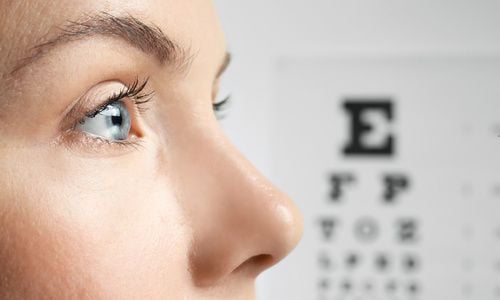
Focus on Your Eyesight During Healthy Vision Month
Maintaining good vision can be as simple as visiting your optometrist for regular checkups and making a few important lifestyle changes. Healthy Vision Month, held every May, is the perfect time to prioritize your vision health.
Regular Eye Exams Are a Must at Every Age
Visiting your eye doctor on a regular basis can help you enjoy clear vision, reduce your risk of developing certain eye diseases, and ensure that you receive prompt treatment if you are diagnosed with an eye disease or condition.
The American Optometric Association recommends this checkup schedule for people who have no symptoms or are at low risk of eye and vision problems:
- Birth to 2 Years. First visit between 6 to 12 months
- Ages 3 to 5. At least one visit during this time period
- Ages 6 to 17. Once before first grade, then annually
- Ages 18 to 64. Every two years
- Ages 65 and older. Every year
Yearly exams are recommended at any age if you wear glasses or contact lenses, have an eye condition or disease or are at increased risk of an eye condition or disease.
During a comprehensive eye examination, your eye doctor tests your ability to see clearly at various distances and examines the internal and external parts of your eye. The exam also includes glaucoma and other tests and drops to dilate your pupils. Dilation gives your optometrist a clear view of the retina and optic nerve at the back of your eye.
Talk Eye Health with Your Family
Certain eye diseases and conditions, including macular degeneration, cataracts, colorblindness, and eye misalignment, tend to run in some families. Sharing information about these conditions and diseases can help protect the entire family, especially if the problems typically appear during childhood. Letting your optometrist know about the diseases you could possibly inherit can help him or her assess your risk and monitor you closely for possible signs of the disease or condition.
Wear Sunglasses Year-Round
Sunglasses aren't just a fashion statement. The glasses can protect your eyes from the harmful effects of ultraviolet A (UVA) and ultraviolet B (UVB) rays. Exposure to these rays can increase your risk of cataracts, macular degeneration, and cancer in and around your eyes.
When buying sunglasses, select glasses that protect you from 100% of UVA and UVB rays. Wrap-around styles provide the most protection and block the rays from entering your eyes through the sides.
Improve Your Diet
A healthy diet benefits every part of your body, including your eyes. When you're shopping, add leans meats and poultry, fish, fresh fruits and vegetables, and whole grains to your cart. Avoid or limit fatty, fried, processed or junk foods.
Step Away from Your Screens
Spending too much time using digital screens can strain your eyes and cause headaches and dry eye. In fact, those symptoms, in addition to blurred vision and sore neck and shoulder muscles, can be symptoms of computer vision syndrome. The syndrome affects both children and adults who use digital devices.
You can lower your risk of developing computer vision syndrome by taking a 15-minute break after two hours on a device. Following the 20-20-20 rule can also be helpful. Look at an object 20 feet in the distance for 20 seconds after viewing a screen for 20 minutes.
Protect Your Eyes from Injury
Do you wear goggles or protective eyewear when you saw a piece of wood or use caustic chemicals? Even a tiny woodchip or a single drop of a chemical can cause a serious eye injury. Donning goggle, face shields or safety glasses before you start a project can help you avoid permanent damage to your eyes.
If you play any sports, it's also important to protect your eyes during games and during practice. Depending on what sport you play, you should either be wearing safety goggles or a helmet with a safety shield. If you are unsure, ask your eye doctor about the appropriate sports protective eyewear.
Put your eye health first by practicing good habits.
Sources:
American Optometric Association: May Is Healthy Vision Month
